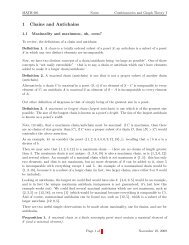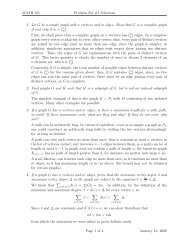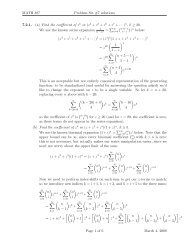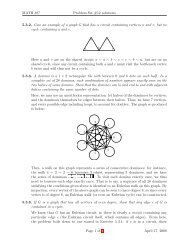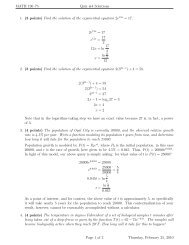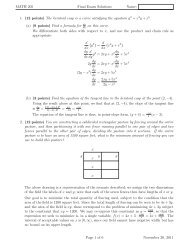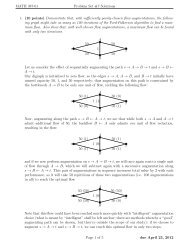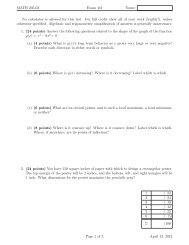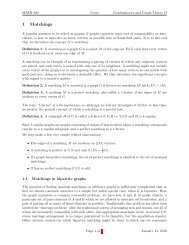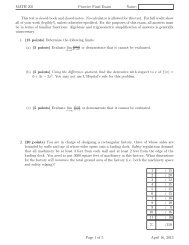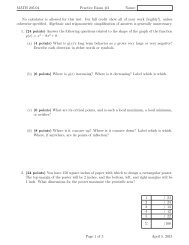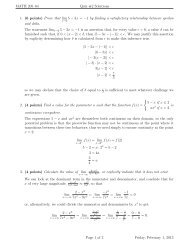MATH 387 Practice Final Exam Solutions 1. (12 points) For the ...
MATH 387 Practice Final Exam Solutions 1. (12 points) For the ...
MATH 387 Practice Final Exam Solutions 1. (12 points) For the ...
Create successful ePaper yourself
Turn your PDF publications into a flip-book with our unique Google optimized e-Paper software.
<strong>MATH</strong> <strong>387</strong><strong>Practice</strong> <strong>Final</strong> <strong>Exam</strong> <strong>Solutions</strong><strong>1.</strong> (<strong>12</strong> <strong>points</strong>) <strong>For</strong> <strong>the</strong> following problem, <strong>the</strong> alphabet used is <strong>the</strong> standard 26-letter Englishalphabet, and “vowels” refers only to <strong>the</strong> letters A, E, I, O, and U.(a) (3 <strong>points</strong>) How many strings of five letters contain at least one vowel?There are 26 5 strings in total, since <strong>the</strong>re are 26 different possible letters in each position.There are 21 5 strings which consist only of consonants, since <strong>the</strong>re are 21 consonants.Thus, <strong>the</strong>re are 26 5 −21 5 fove-letter strings which do not consist entirely of consonants;that is, strings which contain at least one vowel.(b) (3 <strong>points</strong>) How many strings of five letters contain at least one A, at least one B, and atleast one C?Let X be <strong>the</strong> set of all five-letter strings; let A, B, and C be, respectively, <strong>the</strong> sets ofstrings with no As, no Bs, and no Cs. Thus, <strong>the</strong> question above asks to count <strong>the</strong> stringswhich do not appear in any of A, B, and C; which is to say, strings in A∪B ∪C. Asseen above, |X| = 26 5 ; since A, B, and C consist of strings using a 25-letter pool each,|A| = |B| = |C| = 25 5 ; likewise, those sets which consist of strings avoiding 2 letters havea pool of 24 letters to choose from, so |A∩B| = |A∩C| = |B ∩C| = 24 5 , and similarly|A∩B ∩C| = 23 5 . Using <strong>the</strong> principle of inclusion-exclusion:|A∪B ∪C| = 26 5 −3·25 5 +3·24 5 −23 5An exhaustive casewise consideration is also possible but is prone to error through miscounts,overcounts, or omission of cases.(c) (4 <strong>points</strong>) Determine a generating function for a n , <strong>the</strong> number of seven-letter stringswith n vowels. The generating function need not be algebraically simplified.<strong>For</strong> each letter, we ei<strong>the</strong>r have a consonant, in which case <strong>the</strong> choice of that letter does notcontribute a vowel, or a vowel, in which case <strong>the</strong> contribution of that letter increases <strong>the</strong>vowel count by one. Thus, choice of a single letter can yield zero vowels in 21 ways, andone vowel in 5 ways, so <strong>the</strong> generating function describing <strong>the</strong> vowel count in <strong>the</strong> selectionof a single letter is (21 + 5z). Performing this action 7 times gives us a 7-letter string,so <strong>the</strong> generating function for 7-letter strings with <strong>the</strong> number of vowels recorded in <strong>the</strong>exponent of z is (21+5z) 7 .(d) (2 <strong>points</strong>) How many seven-letter strings have exactly 3 vowels?In <strong>the</strong> generating function determined above, we want <strong>the</strong> coefficient of z 3 , which is easilyshown by <strong>the</strong> binomial <strong>the</strong>orem to be ( 73)(21) 4 (5) 3 .2. (<strong>12</strong> <strong>points</strong>)A polynomial can be representedby a sequence of coefficientsfor computational purposes:we consider <strong>the</strong> polynomial a 0 +a 1 x+a 2 x 2 +a 3 x 3 +···a n x n as <strong>the</strong> sequence (a 0 ,a 1 ,...,a n ).(a) (9 <strong>points</strong>) Write an algorithm to multiply <strong>the</strong> two nth-degree polynomials in {a i } and{b i }, and return <strong>the</strong> result in {c i }, using only loops and simple arithmetic operations.Page 1 of 6 April 20, 20<strong>12</strong>
<strong>MATH</strong> <strong>387</strong><strong>Practice</strong> <strong>Final</strong> <strong>Exam</strong> <strong>Solutions</strong>Input: sequences a 0 ,a 1 ,a 2 ,a 3 ,...,a n and b 0 ,b 1 ,b 2 ,b 3 ,...,b nOutput: sequences c 0 ,c 1 ,c 2 ,c 3 ,...,c 2nset c 0 ,c 1 ,c 2 ,...,c 2n to 0;set i to 0;while i ≤ n doset j to 0;while j ≤ n doset c i+j to c i+j +a i b j ;set j to j +1;set i to i+1;return determined values c 0 ,c 1 ,c 2 ,...,c 2nThis works in much <strong>the</strong> same way as we multiply polynomials by hand. We start with<strong>the</strong> constant term of our multiplicand (setting i = 0, so we consider <strong>the</strong> term a 0 ), andmultiply one-by-one by every term of <strong>the</strong> multiplier, recording <strong>the</strong> results to be added to<strong>the</strong> appropriate terms of our result (here we add <strong>the</strong>m to <strong>the</strong> result progressively, whilea traditional hand-multiplication would wait until all were determined to add up rows).Then, we repeat this process with <strong>the</strong> linear term of our multiplicand (setting i = 0, andthus looknig at <strong>the</strong> term a 1 x), and continuing in such fashion until we have multipliedeach individual term of <strong>the</strong> multiplicand by <strong>the</strong> multiplier.(b) (3 <strong>points</strong>) Justify and state a good asymptotic bound in big-O notation on <strong>the</strong> number ofsteps taken by your algorithm.The innermost set of instructions (adding a product to c i+j ) takes constant time, or O(1)time. However, this instruction is repeated when j is 0, j is 1, when j is 2, when j is 3,and so forth up to when j is n, so <strong>the</strong> time timen by performing this set of instructionsn + 1 times is (n + 1) · O(1), or <strong>the</strong> linear time O(n). <strong>Final</strong>ly, since this loop is itselfrepeated over values of i ranging from 0 to n, <strong>the</strong> algorithm as a whole takes a number ofsteps given by (n + 1) · O(n); that is to say, performing a linear procedure n + 1 times,which takes O(n 2 ) steps, also known as quadratic time.3. (<strong>12</strong> <strong>points</strong>) Let G be a graph with n vertices and maximum degree ∆.(a) (6 <strong>points</strong>) Prove that <strong>the</strong> vertices of G can be colored with (∆+1) colors without using<strong>the</strong> same color on two adjacent vertices.Capsule version: consider coloring <strong>the</strong> vertices one by one, in an arbitrary order. At eachstage, we are coloring a vertex with ≤ ∆ neighbors, so <strong>the</strong>re are ≤ ∆ colors adjacent tothat vertex. Thus, <strong>the</strong>re are ≤ ∆ colors which are used on vertices adjacent to our currentvertex, which we are forbidden to use at that vertex; since <strong>the</strong>re are ∆+1 colors in total,<strong>the</strong>re must thus be at least one color which is not forbidden to use to color <strong>the</strong> vertexunder consideration. Let us use such a color on <strong>the</strong> current vertex, and continue in such afashion until all vertices are colored. Since we have shown that at each stage of <strong>the</strong> processwe are capable of coloring <strong>the</strong> current vertex, this process must necessarily be successfulin coloring all <strong>the</strong> vertices of G with ∆+1 colors.(An inductive proof is also possible, for greater formalism)n(b) (6 <strong>points</strong>) Prove that <strong>the</strong>re is a set of at least vertices in G such that no two of <strong>the</strong>m∆+1are adjacent.Consider a coloring of <strong>the</strong> variety shown to be possible in part (a). This may be consideredto be a partition of <strong>the</strong> vertices into “color classes”, consisting of all vertices of color 1,Page 2 of 6 April 20, 20<strong>12</strong>
<strong>MATH</strong> <strong>387</strong><strong>Practice</strong> <strong>Final</strong> <strong>Exam</strong> <strong>Solutions</strong>all vertices of color 2, and so forth up to color ∆+<strong>1.</strong> Since we are distributing n objectsinto ∆+1 categories, <strong>the</strong> Pigeonhole Principle guarantees that one category has at least⌈ nn⌉ objects in it – thus, <strong>the</strong>re must be ⌈ ⌉ vertices in this coloring which are all <strong>the</strong>∆+1 ∆+1same color, and by <strong>the</strong> conditions provided for our coloring, this set of vertices has no twoadjacent to each o<strong>the</strong>r.4. (<strong>12</strong> <strong>points</strong>) Consider <strong>the</strong> following grid, in which <strong>the</strong> <strong>points</strong> (2,1) and (4,5) are missing.(a) (9 <strong>points</strong>) How many ways are <strong>the</strong>re to walk directly from <strong>the</strong> lower left corner of <strong>the</strong>grid to <strong>the</strong> upper right?LetX consistofallgrid-walksfrom(0,0)to(5,6)onagridwithoutanymissing<strong>points</strong>,andlet A and B be those walks which pass through (2,1) and (4,5) respectively. Obviously,to find walks on <strong>the</strong> given grid, we want to avoid <strong>the</strong>se two <strong>points</strong>, so walks on <strong>the</strong> gridwith <strong>the</strong> omitted point are those in A∪B. Since we have a walk consisting of 5 steps to<strong>the</strong> east and 6 steps to <strong>the</strong> north, an element of X can be identified by selecting 5 of 11steps as eastwards and leaving <strong>the</strong> rest as northwards, so |X| = ( 115). Walks in A can beidentified as a walk from (0,0) to (2,1), which can be done in any of ( 32)ways, toge<strong>the</strong>rwith a walk from (2,1) to (5,6), which can be done in any of ( (83)ways, so |A| =3 82)(3).Likewise, |B| = ( 9 24)(1). <strong>Final</strong>ly, we calculate |A∩B|, which is <strong>the</strong> number of assembliesof three walks: from (0,0) to (2,1), which can be done in ( 32)ways, from (2,1) to (4,5),which can be done in ( (62)ways, and from (4,5) to (5,6), which can be done is21)ways, so|A∩B| = ( 3 6 22)(2)(1). By inclusion-exclusion, we thus determine that <strong>the</strong> desired numberof valid walks is|A∪B| =( ) ( )( ( )( ( )( )( 11 3 8 9 2 3 6 2− − +5 2 3)4 1)2 2 1)(b) (3 <strong>points</strong>) How many ways are <strong>the</strong>re to walk directly through <strong>the</strong> grid from <strong>the</strong> lower leftto upper right if one must walk through <strong>the</strong> point (3,3)?Let X consist of all walks from (0,0) to (3,3), ignoring <strong>the</strong> possibility of missing <strong>points</strong>,and Y consist of all walks from (3,3) to (5,6); to account for <strong>the</strong> missing <strong>points</strong>, weconsider <strong>the</strong>ir subsets A, consisting of paths from (0,0) to (3,3) through (2,1), and B,consisting of paths from (3,3) to (5,6) through (4,5). The number of paths from (0,0) to(3,3) avoiding (2,1) is thus |X|−|A|, and likewise <strong>the</strong> nubmer of paths from (3,3) to (5,6)avoiding (4,5) is |Y| − |B|. Since a path through (3,3) is constructed by picking one ofeach of <strong>the</strong>se subpaths and attaching <strong>the</strong>nm at (3,3), <strong>the</strong> total number of paths from (0,0)to (5,6) passing through (3,3) and avoiding <strong>the</strong> removed <strong>points</strong> is (|X|−|A|)(|Y|−|B|).We can easily calculate |X| to be ( (63), |A| to be3 3(2)(1), |Y| to be5(2), and |B| to be3 21)(1),so our result is [( ( )( )][( ( )( 6 3 3 5 3 2− −3)2 1 2)1 1)]5. (<strong>12</strong> <strong>points</strong>)Page 3 of 6 April 20, 20<strong>12</strong>
<strong>MATH</strong> <strong>387</strong><strong>Practice</strong> <strong>Final</strong> <strong>Exam</strong> <strong>Solutions</strong>(a) (7 <strong>points</strong>) Find a recurrence relation and initial conditions for <strong>the</strong> number of n-digit sequencesof digits from {1,2,3,4,5,6,7} with no two even numbers appearing consecutively.Let us call a sequence “good” if it does not have two adjacent even numbers, and denoteby a n <strong>the</strong> number of good sequences. The recurrence relation is motivated by <strong>the</strong> question:howdowebuildagoodsequencefromsmallergoodsequences? Appendinganoddnumbertoagoodsequenceclearlyresultsinano<strong>the</strong>rgoodsequence; butappendinganevennumberis only possible if an odd number precedes it. Thus, we can get every good sequence oflength n in one of two ways: ei<strong>the</strong>r append an odd number to a good sequence of lengthn−1, or append an odd number and <strong>the</strong>n an even number to a good sequence of lengthn−2. Thereare4odddigitsavailabletous, anda n−1 goodsequencesoflengthn−1, so<strong>the</strong>first construction method yields 4a n−1 good sequences of length n; <strong>the</strong> second constructionmethod has an option of 4 different odd digits, 3 even digits, and a n−2 sequences of lengthn − 2, so this construction can be completed in <strong>12</strong>a n−2 different ways. Thus, <strong>the</strong>re are4a n−1 +<strong>12</strong>a n−2 sequences of length n in total, so by our definition of a n , this sequence issubject to <strong>the</strong> recurrence a n = 4a n−1 +<strong>12</strong>a n−2 .<strong>For</strong> initial conditions, we consider <strong>the</strong> number of zero-digit good sequences (of which <strong>the</strong>reis only 1, <strong>the</strong> null sequence), and <strong>the</strong> number of one-digit good sequences (of which <strong>the</strong>reare 7, since any digit could be used). Thus a 0 = 1 and a 1 = 7.(b) (5 <strong>points</strong>) Solve <strong>the</strong> recurrence relation determined above.The characteristic equation of <strong>the</strong> recurrence relation above is x 2 = 4x + <strong>12</strong>, which hasroots x = 6 and x = −2, as can be determined by solving <strong>the</strong> quadratic. Thus, <strong>the</strong>general solution to <strong>the</strong> recurrence a n = 4a n−1 +<strong>12</strong>a n−2 is a n = k 1 6 n +k 2 (−2) n . The initialconditions are neceesary to determine k 1 and k 2 . Looking at <strong>the</strong> particular cases of n = 0and n = 1, <strong>the</strong> above equation becomes:{1 = k1 + k 26. (<strong>12</strong> <strong>points</strong>)7 = 6k 1 −2k 2Solving this system of equations gives k 1 = 9 8 and k 2 = − 1 8 , so a n = 9(6n )−(−2) n8.(a) (3 <strong>points</strong>) How many ways are <strong>the</strong>re to rearrange <strong>the</strong> letters of <strong>the</strong> word “BARBER”?This is a rearragement of 2 identical items (<strong>the</strong> Bs), 2 identical items (<strong>the</strong> Rs), 1 uniqueitem (<strong>the</strong> A) and ano<strong>the</strong>r unique item (<strong>the</strong> E), so, since we want to position 4 classes ofitems, a multinomial coefficient is ideal, giving ( 62,2,1,1)= 180.(b) (4 <strong>points</strong>) How many rearrangements of <strong>the</strong> letters of <strong>the</strong> word “BARBER” do not have<strong>the</strong> “B”s adjacent to each o<strong>the</strong>r?We take <strong>the</strong> above-counted set, and subtract off those in which <strong>the</strong> Bs are adjacent. Tocount <strong>the</strong> arrangements with <strong>the</strong> Bs adjacent, we consider BB as a monolithic element in<strong>the</strong> rearrangement, so we now have 5 letters, 2 identical (<strong>the</strong> Rs), and 3 unique (<strong>the</strong> A,E, and BB). So <strong>the</strong>re are ( 52,1,1,1)= 60 arrangements in which <strong>the</strong> Bs are adjacent to eacho<strong>the</strong>r, so <strong>the</strong>re are ( ) (62,2,1,1 − 52,1,1,1)= <strong>12</strong>0 arrangements in which <strong>the</strong>y are not adjacent.(c) (5 <strong>points</strong>)Construct (but do not algebraically simplify) an exponential generating functionfor <strong>the</strong> number of n-letter strings which can be constructed from <strong>the</strong> letters of <strong>the</strong> word“BARBER”.Page 4 of 6 April 20, 20<strong>12</strong>
<strong>MATH</strong> <strong>387</strong><strong>Practice</strong> <strong>Final</strong> <strong>Exam</strong> <strong>Solutions</strong>Let us consider this as a product of 4 selection functions: one choosing to place Bs,one placing Rs, one placing Es, and one placing As. Due to <strong>the</strong> multiplication principleof exponential generating functions, all rearrangements will be enumerated merely byperforming multiplications, so we need to only write our base selection functions to selectby <strong>the</strong> number of letters chosen. <strong>For</strong> instance, <strong>the</strong>re are 3 possible words to be producedwith B alone: <strong>the</strong> null word, <strong>the</strong> word “B”, and <strong>the</strong> word “BB”. Classifying <strong>the</strong>se words bylength, this corresponds to <strong>the</strong> generating function (1) z00! +(1)z1 1! +(1)z2 = 1+z+ z2.The2! 2selection function for words made from <strong>the</strong> letter R will be indentical. A and E, howeveronly admit two possibilities: a zero-letter or a one-letter word, so <strong>the</strong>ir selection functionsare (1) z00!+(1) z11!= 1+z. Thus, multiplying all <strong>the</strong>se toge<strong>the</strong>r, we have(1+z + z22 )2 (1+z) 2Note: actually multiplying <strong>the</strong>se out is beyond <strong>the</strong> scope of this exam, however, if onewere to do so, we could find <strong>the</strong> nubmer of one-letter, two-letter, etc. words constructablewith <strong>the</strong>se letters from <strong>the</strong> expansion and canonical representation of <strong>the</strong> exponentialgenerating function:( ) ( ) ( ) ( ) ( )z2 z3 z4 z5 z61+4z +14 +42 +102 +180 +1802! 3! 4! 5! 6!Note, in particular, that <strong>the</strong> coefficient of z66!is, as would be expected, <strong>the</strong> answer to part(a).7. (<strong>12</strong> <strong>points</strong>) Attila, Béla, Cili, and Desző are dividing up a collection of identical stamps. Theyhave decided that none of <strong>the</strong>m should get more than 8 or fewer than 2 stamps.(a) (4 <strong>points</strong>) Using classical methods, determine how many ways <strong>the</strong>re are for <strong>the</strong>m todistribute <strong>the</strong> stamps if <strong>the</strong>re are 20 stamps total.Let us pre-emptively hand out <strong>the</strong> requisite 2 stamps to each person, depleting our stockby 8; thus, this problem is identical to <strong>the</strong> question of how to give each person betweenzero and six stamps from a pool of <strong>12</strong>.Let X consist of all possible distributions of stamps to <strong>the</strong> four philatelists; Let A 1 , A 2 , A 3 ,and A 4 represent those distributions which give a particular person more than 6 stamps.Using <strong>the</strong> distribution statistic for undistinguished objects to distinct recipients (or <strong>the</strong>“balls and walls” argument used to justify that statistic) we may see that |X| = ( 153).Now, A 1 (and by analogy <strong>the</strong> o<strong>the</strong>r A i s) consists of those arrangements in which Atilla(or someone else, in <strong>the</strong> case of <strong>the</strong> o<strong>the</strong>r A i ) has at least 7 stamps. If we assign Attila aration of 7 stamps, <strong>the</strong>n <strong>the</strong>re are 5 left to be distributed; this can be done in ( 83)ways,so |A i | = ( 83).If we consider <strong>the</strong> intersection of some A i and A j , this would consist of those arrangementsin which two people have at least 7 stamps each; distributing <strong>12</strong> stamps, this is a clearimpossibility, so |A i ∩A j | = 0, and likewise larger intersections will be empty.Thus, by inclusion-exclusion,( 15|A 1 ∪A 2 ∪A 3 ∪A 4 | = |X|−4|A i | =3).( 8−4 = 2313)Page 5 of 6 April 20, 20<strong>12</strong>
<strong>MATH</strong> <strong>387</strong><strong>Practice</strong> <strong>Final</strong> <strong>Exam</strong> <strong>Solutions</strong>(b) (4 <strong>points</strong>) Construct a generating function for <strong>the</strong> number of ways to distribute n stampsin this manner. The generating function need not be algebraically simplified.Each person can get between 2 and 8 stamps, and each number of stamps can only beachieved in one way (since <strong>the</strong> stamps are all identical); thus, <strong>the</strong> generating function fordistributing stamps to a single individual is (z 2 +z 3 +z 4 +z 5 +z 6 +z 7 +z 8 ), and multiplyingtoge<strong>the</strong>r each individual’s stamp-selection finction, we get (z 2 +z 3 +z 4 +z 5 +z 6 +z 7 +z 8 ) 4 .(c) (4 <strong>points</strong>) Using algebraic manipulations of your generating function, determine its z 20coefficient.(z 2 +z 3 +z 4 +z 5 +z 6 +z 7 +z 8 ) 4 = (z 2 ) 4 (1+z +z 2 +z 3 +z 4 +z 5 +z 6 ) 4= z 8 ( 1−z71−z) 4= z 8 (1−z 7 ) 4 1(1−z) 4= z 8 (1−4z 7 +6z 14 −4z 21 +z 28 )= (z 8 −4z 15 +6z 22 −4z 29 +z 36 )∞∑( ) n+3z n3∞∑( n+3We see two terms in this product that could contribute to a z 20 term: (z 8 ) [( ) ] <strong>12</strong>+33 z<strong>12</strong>and (−4z 15 ) [( ) ] 5+33 z5. Adding <strong>the</strong>m toge<strong>the</strong>r, we get <strong>the</strong> term [( (153)−483)]z 20 , so <strong>the</strong>coefficient of z 20 is ( (153)−483)= 23<strong>1.</strong>Note that this is <strong>the</strong> same as <strong>the</strong> answer to part (a), since it is counting <strong>the</strong> same thing.n=0n=03)z nPage 6 of 6 April 20, 20<strong>12</strong>




